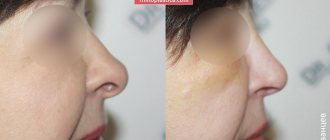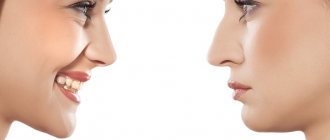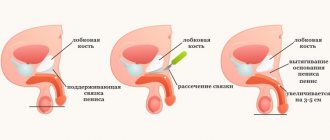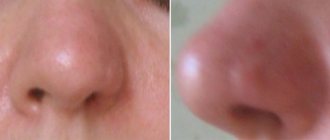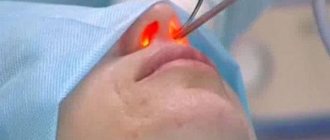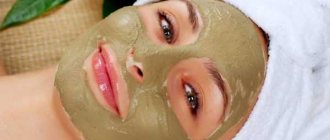Open rhinoplasty
Incisions are made externally, in the columella area. In this case, the surgeon gains full access to the osteochondral segment and can carry out any manipulations, clearly controlling them and simulating the result.
The disadvantage is the presence of postoperative scars in the visible area on the face. However, it is worth considering that they become invisible over time, albeit a long one.
What is the fundamental difference between open and closed rhinoplasty?
The closed technique is used when it is not necessary to radically change the appearance, to carry out serious intervention in the structure of the osteochondral structure, and the existing defects are minor. Open surgery makes it possible to eliminate even serious problems and correct the consequences of severe injuries, congenital pathologies, and pronounced asymmetry. In addition, it is the open method that is used for secondary plastic surgery, when it is necessary to remove the consequences of a poorly performed operation in the past.
Indications for closed plastic surgery:
- the presence of a contraindication to open surgery;
- hump;
- excessively wide wings of the nose;
- hook-shaped or drooping tip of the nose.
Indications for open plastic surgery:
- congenital pathology;
- unsuccessful rhinoplasty in the past;
- traumatic deformation of the nose;
- asymmetry.
General contraindications for surgery:
- cardiovascular diseases;
- oncology;
- diabetes;
- blood clotting disorder;
- acute infectious diseases, as well as chronic ones in the acute stage;
- infections and inflammation in the area of intervention;
- age under 18 years;
- pregnancy and lactation.
Briefly about the open access method
The open technique of nose correction is performed through an incision made across the columella (the partition between the nostrils) in the shape of the English letter W. This method allows you to fully open the surgical field and correct all internal defects that led to external changes. With the open technique, the surgeon gains access to all structures - bones, lateral cartilages, ligaments, subcutaneous fat layer.
Advantages of open technology:
- Maximum predictability and stability of results;
- Versatility - the method is designed to eliminate isolated and general defects, while it becomes the only correct solution when performing secondary, post-traumatic, structural rhinoplasty;
- Reduced likelihood of medical error due to normal visualization;
- Possibility of correcting obvious and severe defects - curvature, massiveness, asymmetry, etc.;
The incision site becomes invisible within 2-3 months after surgery. Professional surgeons work with tissues very delicately and many patients, 1-2 years after plastic surgery, find it difficult to show the place where the incision was.
Disadvantages of open rhinoplasty:
The disadvantages of the open technique often include the same incision on the columella and a longer recovery.
It is surprising for many, but recovery after an open operation is exactly the same as after a closed method - after all, with both methods of correction, the skin flap of the nose is peeled off, and the same tissues, cartilages and bones are injured.
Visual manifestation of the incision site on the columella (patients vary)
The disadvantages of open rhinoplasty objectively outweigh its advantages. The accuracy of the surgeon automatically reduces possible injuries from the open approach.
Preparation for open and closed rhinoplasty of the nose
After consultation with the surgeon, the patient undergoes an examination. It includes:
- fluorography;
- passing a general urine test;
- passing a general and biochemical blood test, a coagulation test;
- blood tests for hepatitis, syphilis, HIV;
- ECG;
- X-ray, MRI or CT scan of the intervention area.
Next, you need to visit a therapist and anesthesiologist.
Before surgery, it is recommended to quit smoking 14 days before, and alcohol 3 days before. The day before (8-10 hours before the intervention) do not eat or drink.
Rhinoplasty is work on the appearance of the nose and its correction. Rhinoplasty is divided into 2 types – open and closed. And, more often than not, the surgeon supports and practices one of these methods. Thus, we can talk about the existence of two opposing sides, each of which supports one or another method. I believe that such a one-sided approach is incorrect and the most correct thing is to combine both of these methods, using in each of them certain technical techniques from the other.
It is customary to distinguish the main groups of patients based on general problems:
- A long nose. Problems with the tip of the nose (wide, pendulous or small).
- Hump of the nose.
- Curvature of the nose.
These are 3 main groups. Often all three are combined.
- There are also many more problems associated with the regional properties of peoples, the so-called “typical noses”: Africa - wide nostrils, large tips, Asia - small noses, practically no bridge of the nose, Southern peoples - hump, etc.
- And it is worth highlighting patients with breathing problems as a separate group.
By the way, previously noses were operated on only at a young age (before 30 years), since it was believed that the skin could not shrink and the shape of the nose could not become the desired one. But with the development of rhinosurgery, new technical techniques have appeared, with the help of which surgeons have the opportunity to operate on people of an older age group (radiosurgery scalpel, laser, etc.).
In open rhinoplasty, an incision is made on the columella (middle part of the nose), at its narrowest point, as a result of which the rest of the skin above the cartilage peels off and rises. In this way, all cartilage is exposed and, depending on the problem that needs to be solved, work is carried out at all stages of the operation.
With open rhinoplasty, as with closed rhinoplasty, scars form within a year, so-called fibrosis, which stabilizes or deforms the results of the operation. The better the surgeon’s technique, the smaller and more delicate this fibrosis, and, accordingly, the more predictable and stable the result of the operation. The final result becomes visible after about six months to a year. The skin is not cut off, but is placed on the new nasal frame and subsequently shrinks on its own.
With open rhinoplasty, you can approach the septum completely freely and either work with it in place, or pull it out and model it when removed. Then the septum is clearly fixed and sutured to the bone. Open rhinoplasty allows you to clearly model the external and internal valves, which will ensure normal nasal breathing. Thus, here we can confidently say about the good functional and aesthetic outcome of the operation. With this method it is quite difficult to harm the patient.
Closed rhinoplasty means that all incisions are made internally . The advantage of the method is that the arteries supplying the tip of the nose in the columella are not damaged. Thus, recovery occurs faster than with the open method.
The following point seems fundamental to me: there are surgeons who perform destructive rhinoplasty, that is, after the first stage of closed rhinoplasty, the cartilage is not sutured, and scarring itself will put everything in place. But, unfortunately, this never happens. And the most complications occur when scarring does not go as desired. To perform closed rhinoplasty, special instruments are needed. By the way, the Beauty Doctor clinic has such tools.
Closed rhinoplasty is much more complicated than open rhinoplasty. It is not for nothing that most experienced rhinosurgeons, including my teachers, say that closed rhinoplasty should be performed after you have done at least 100 open rhinoplasties with excellent results. Among experienced plastic surgeons, there is an opinion that a surgeon is either able to do rhinoplasty or not.
***
To summarize, I would like to note that both of these methods - open and closed - have existed and will continue to exist. They cannot be opposed, since each of them has advantages and disadvantages. In my practice, I choose a methodology based on the patient’s problems, and often combine some from one and some from another method. Open rhinoplasty allows for maneuver during the operation, while closed rhinoplasty has its advantages. Again, it all depends on the problems. I always use the method in which I am more confident in this case and which is more likely to give a stable result.
Description of operations
- Open rhinoplasty is performed through an external approach. Incisions are made in the narrowest part of the columella. The skin over the cartilage then peels off and lifts. After the necessary manipulations, cosmetic stitches are applied.
- Closed rhinoplasty is performed through internal incisions in the mucous membranes. There are no traces of the intervention, but deformation of the cartilaginous area is often required.
Both types of operations are performed under general anesthesia and can last from 30 minutes to several hours, depending on the volume and complexity of the intervention.
After rhinoplasty, the patient remains in the hospital for 1-2 days.
Which plastic surgery do you prefer?
The specialist determines whether the intervention should be carried out openly or closed. It takes a number of factors into account:
- Own qualifications. When internal structures are hidden, there is no direct visibility of manipulation. Therefore, this method is chosen by more experienced surgeons.
- Severity of defects. In some cases, imperfections can only be eliminated using an open method, for example, when installing endoprostheses.
- Scope of intervention. Large-scale operations are performed in an open manner, for example to eliminate a concave area.
- Past operations. If a correction has already been made, and its results did not satisfy the patient, an open technique is preferable for repeated intervention.
! Rhinoplasty in our clinic - more details about the procedure, prices, reviews, before and after photos
Rhinoplasty as part of a comprehensive correction of appearance
Needless to say, the perception of appearance depends not only on the shape of the nose. The harmonious contours of the face are determined by the severity of the zygomatic eminence, the shape of the eyes, the position of the eyebrows, the shape of the lips and chin. The aesthetic value of rhinoplasty is largely determined by the individual characteristics of the patient’s appearance. That is why in recent years there has been a trend towards a radical improvement in appearance, which includes a complex of surgical operations.
Complex modeling of facial features formed the basis of a new direction of plastic surgery - omorphioplasty (from the Greek "omorphia" - beauty). As part of omorphioplasty, correction of the shape of the nose can be supplemented with periorbitoplasty, lower or upper blepharoplasty, malarplasty, cheiloplasty and genioplasty.
Only an experienced plastic surgeon who can see even hidden aesthetic defects and knows how to correct them can create a comprehensive program for transforming one’s appearance. It is important to understand that in one case, in addition to rhinoplasty, it is enough to change the position of the eyebrows, while other patients will need correction of the shape of the chin or orthognathic surgery to create a Hollywood appearance.
Open rhinoplasty
Unlike closed rhinoplasty, the external, or open, technique involves making a small incision in the fold of skin that separates the outside of the nasal passages. It is called a transcolumellar incision and is made to connect the incisions in the area of the right and left nostrils. As a result, a section of nasal skin can be pulled upward (much like opening the hood of a car), allowing an unobstructed view of the underlying nasal “frame.” Moreover, all parts of the nose that may require surgical correction are visible unchanged, without stretching or displacement, which improves the planning and accuracy of the surgeon’s further actions. Open surgical access makes it possible to see even minor defects and choose the most effective and safe way to eliminate them.
Thus, the external small postoperative scar, which after weeks will smooth out and disappear, is completely compensated by the high precision, versatility and effectiveness of open rhinoplasty.
Features of revision rhinoplasty
Secondary or tertiary rhinoplasty is performed for aesthetic and medical reasons. The reason for a repeat operation may be the patient’s dissatisfaction with the results of primary plastic surgery, which does not always have real reasons. Often, a person’s mental characteristics push him to return to the surgeon, although the shape of the nose is almost ideal. Medical indications include functional disorders in the form of impaired sense of smell and/or external respiration.
Secondary plastic surgery is a more complex operation for both the surgeon and the patient. After primary rhinoplasty, there is some scar tissue in the nose. The anatomy of bone and cartilaginous structures, albeit slightly, is disturbed, and this also has to be taken into account when performing the operation. The psychological state of the patient, who will once again have to go through a difficult recovery period, cannot be discounted.
Despite the presence of unfavorable factors, with secondary plastic surgery it is possible to achieve a good aesthetic result using internal access. The recovery period after secondary rhinoplasty has its own characteristics. Swelling and hematomas persist longer. The duration of the rehabilitation period increases, and compliance with the recommendations of the plastic surgeon becomes of enormous importance.
Rhinoplasty: advantages of closed access
The choice of access for rhinoplasty is largely determined by the qualifications of the plastic surgeon. A complete overview of the open surgical field provides visual control over the manipulations performed by the surgeon. This simplifies open rhinoplasty and reduces the risk of medical error, but what is good for the surgeon often goes against the interests, wishes and needs of the patient.
With open access, significant disruption of tissue integrity occurs. The high morbidity of open rhinoplasty is associated with a high risk of complications, in particular, deviation of the nose and the formation of rough scar layers. Complex rehabilitation in combination with an increase in the duration of the recovery period cannot be ignored. At best, you will be able to evaluate the result of the correction in six months, but the final formation of new contours, as a rule, takes about 12 months.
Performing rhinoplasty using a closed approach is more difficult, but the difficulties for the surgeon result in benefits for his patient. Endonasal access is accompanied by minimal tissue trauma and avoids the formation of a visible postoperative scar. Yes, the closed method requires high qualifications and extensive experience, but from the patient’s point of view this cannot be a disadvantage. The professionalism of the doctor is the main argument in favor of the operation.
Other benefits of closed rhinoplasty are less obvious, but no less compelling. Endonasal access reduces the severity of swelling, bruising, pain and discomfort in the early period of rehabilitation. With closed rhinoplasty, the time under anesthesia is reduced, which, combined with the low traumatic nature of the operation, reduces the risk of complications and speeds up recovery. The result is visible after 3 months, and you can fully enjoy your new appearance in just six months.
The advantages of closed rhinoplasty may lead one to believe that the open approach has no advantages and is used only by young surgeons. This is wrong. In difficult cases, a high aesthetic result can be achieved only with the help of open plastic surgery. Secondary and tertiary rhinoplasty is associated with objective difficulties, which we will discuss within the framework of this material, and therefore revision rhinoplasty can be performed using an open approach. In other situations, closed rhinoplasty should be preferred.
When is open rhinoplasty used?
- In many cases, open rhinoplasty is the preferred method for primary rhinoplasty, as it improves diagnostic accuracy and makes it possible to correct the full extent of nasal defects.
- The method of choice for revision rhinoplasty when it is necessary to correct the consequences of mistakes or side effects during a previous nose job.
- With congenital malformations of the nose and upper palate;
- For the correction of post-traumatic changes in the bones and cartilage of the nose.
In each specific case, either open or closed rhinoplasty can be chosen as the main method. Both operations are high-tech and require excellent practical skills from the plastic surgeon.
© Tigran Aleksanyan 2010-2020. Plastic surgeon in Moscow – personal website.
